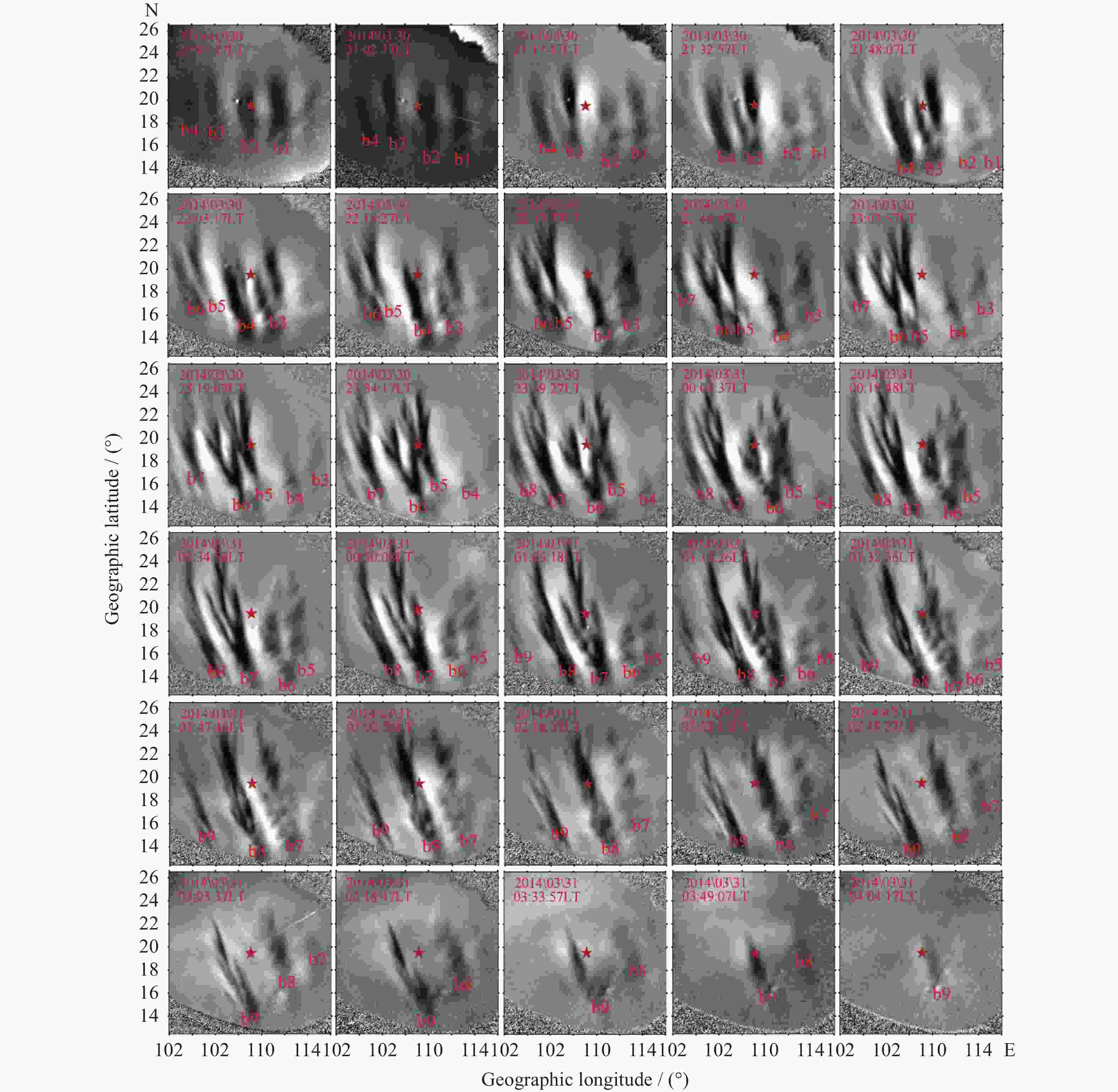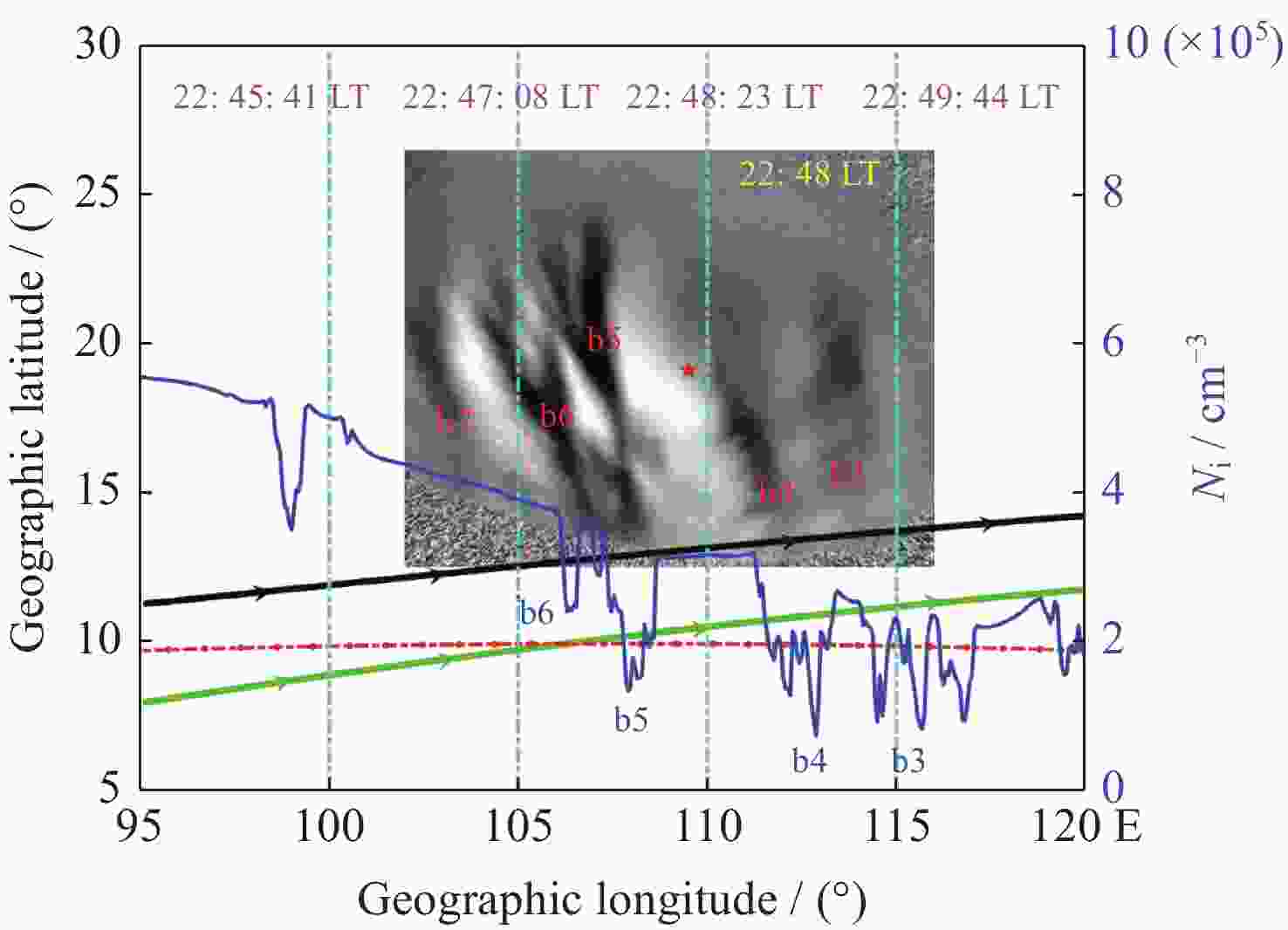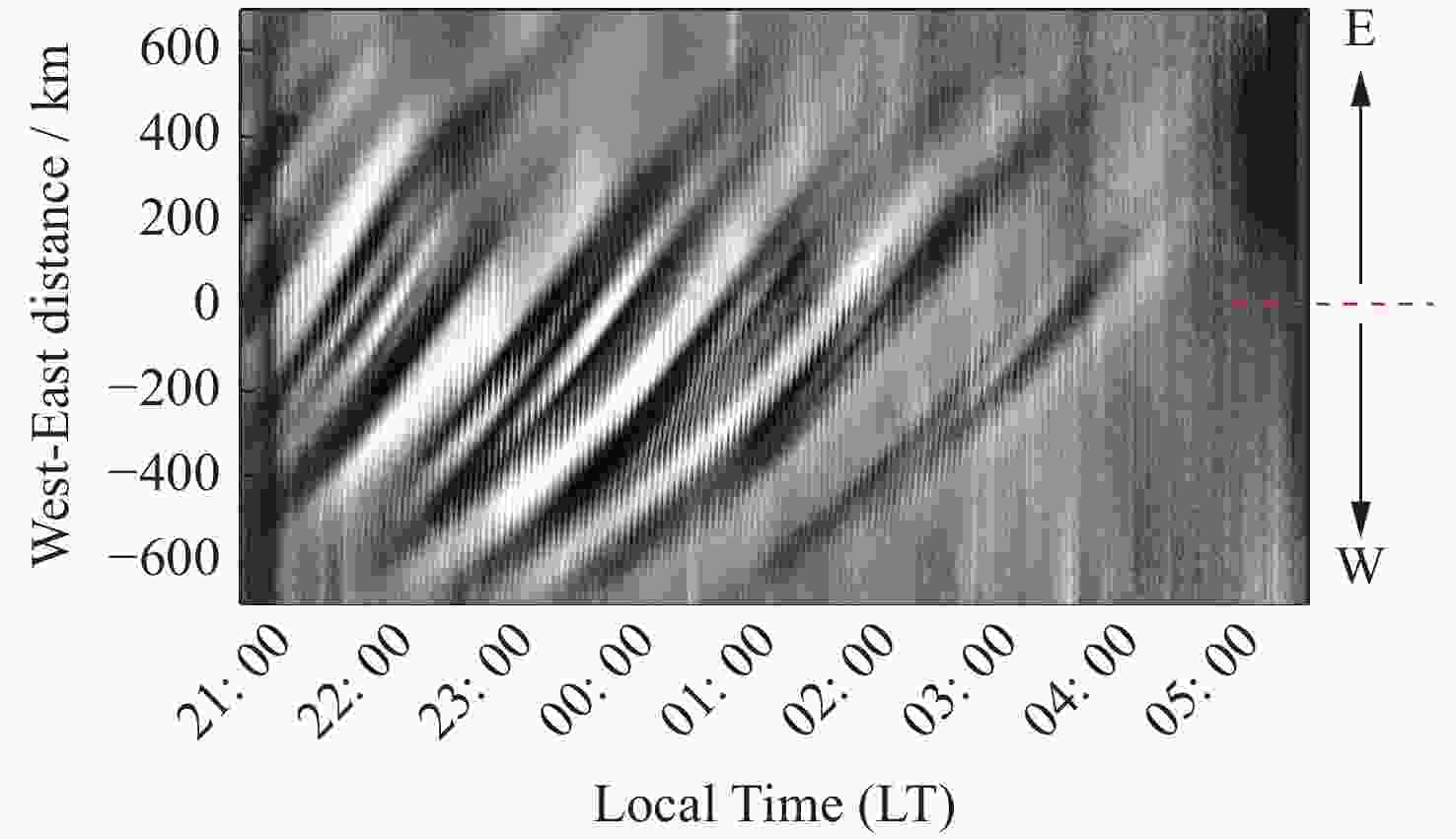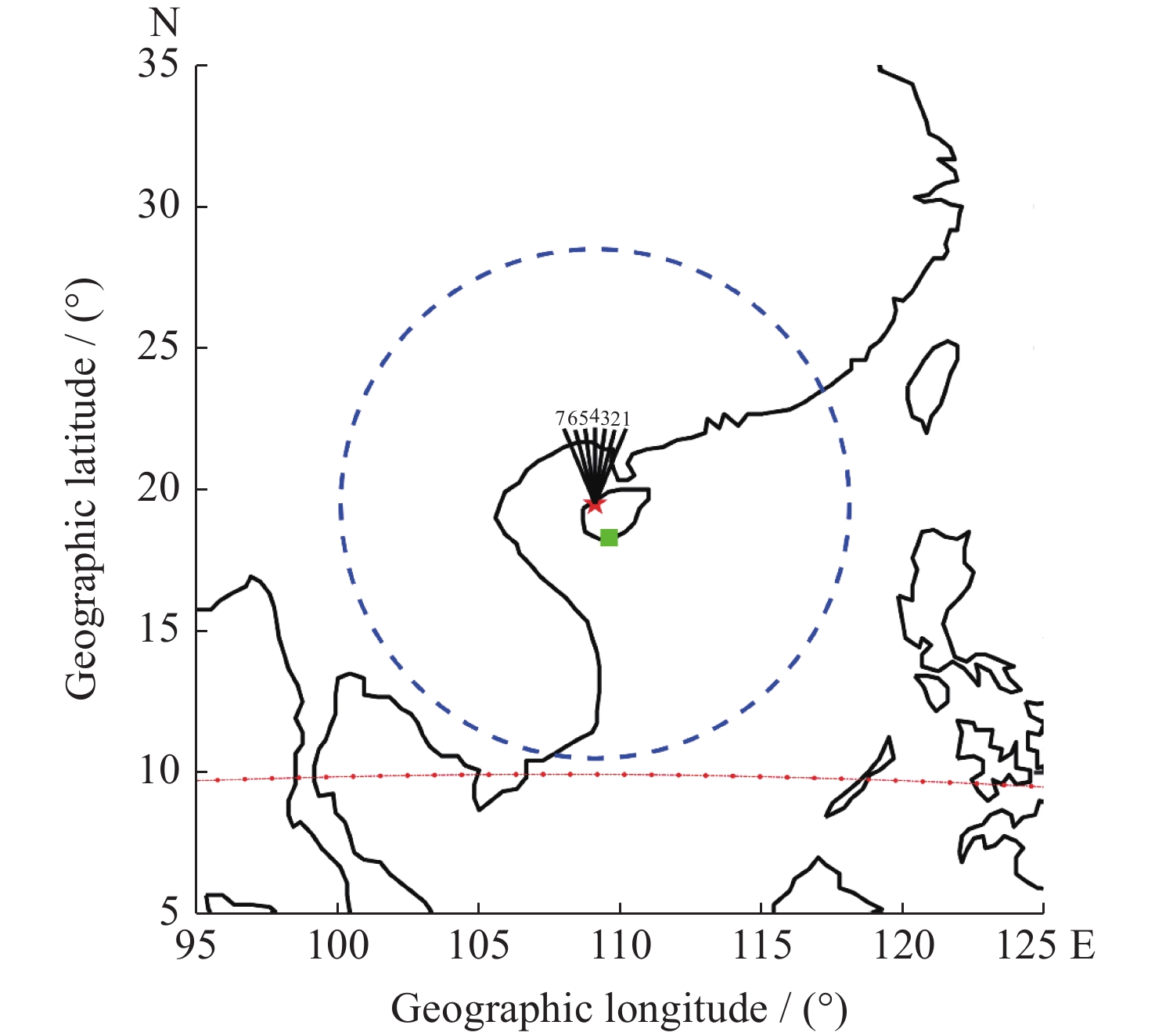中国上空夜间电离层等离子体泡群演化过程的多设备观测
doi: 10.11728/cjss2023.03.2022-0030 cstr: 32142.14.cjss2023.03.2022-0030
Evolution of Equatorial Plasma Bubbles Group Simultaneously Observed by Multi-instruments over China
-
摘要: 利用子午工程富克站(19.5°N, 109.1°E)全天空气辉成像仪、VHF雷达、三亚站(18.4°N, 109.6°E)数字测高仪及C/NOFS卫星观测数据,对2014年3月30日中国上空的等离子体泡进行了研究。结果表明,当天夜间观测到一个等离子体泡群,约由9个等离子体泡组成,发生在日落后,一直持续到午夜后。其自西向东运动,南北向最大尺度超过1200 km,东西向绵延超过1400 km,在演化中部分结构融合在一起。等离子体泡被气辉成像仪观测到的同时,数字测高仪及VHF雷达观测到了相应扩展F及羽毛状不规则结构。同时,C/NOFS卫星检测到相应电子密度耗散。这表明,该等离子体泡同时被地基光学观测、无线电探测及C/NOFS卫星观测到。研究结果给出了多仪器同时观测到的等离子体泡群演化过程,丰富了多仪器融合研究电离层不规则体的内容。Abstract: The Equatorial Plasma Bubbles (EPB) of 30 March 2014 were studied using airglow images of 630 nm emission from all-sky imager and observations of Viral Hemorrhagic Fever (VHF) radar over Hainan Fuke Station (19.5°N, 109.1°E) from the Chinese Meridian Project, digisonde over Hainan Sanya Station (18.4°N, 109.6°E), and data of the Communication/Navigation Outage Forecasting System (C/NOFS). In this case, the morphological features and evolution processes of these EPBs were analyzed and studied in detail. The results showed that there was a group of EPB over China during the night of 30 March 2014. The EPB group includes about nine EPB which were simultaneously observed by multi-instrument. These EPBs occurred after sunset, lasting after midnight. The lifetime of the EPBs is about eight hours (from 20:15 LT to 04:15 LT). These EPB moved from west to east during the night. The maximal scale of their longitudinal ranges is more than 1200 km. East-west ranges of the EPB group are more than 1400 km. Besides, two EPBs showed a merging process in the evolutionary process. Portion of b6 merged into the other EPB and then formed into one EPB. When these EPBs were observed by the all-sky imager, the corresponding range spread F and plume irregularities were also simultaneously observed by the digisonde and VHF radar, respectively. Meanwhile, observations from C/NOFS also showed plasma depletion over the same period. Evolutions of these EPBs were simultaneously observed by optical equipment (all-sky imager) and radio equipment (VHF radar and digisonde) of ground-based measurements, and C/NOFS satellite. The observation results show that evolution of these EPBs which is simultaneously observed by multi-instrument. These observation results and the study enrich research of ionospheric irregularity based on observations of multi-instrument.
-
Key words:
- Equatorial plasma bubble /
- All-sky imager /
- Digisonde /
- VHF radar /
- C/NOFS satellite
-
图 1 使用仪器的地理位置。红色星代表富克台站地理位置,绿色方块代表三亚台站地理位置,蓝色圈代表全天空气辉成像仪250 km高度处的观测视场,黑色直线代表VHF雷达的7个波束大致位置,红色点线代表磁赤道
Figure 1. Location of instruments. The red star shows the location of Fuke station. The green square represents the location of Sanya station. The blue circle represents the FOVs of all-sky imager at an altitude of 250 km. The black lines represent 7 beams of VHF radar. The red dotted line is the magnetic equator
图 2 2014年3月30-31日海南富克观测站20:47-04:04 LT观测到的等离子体泡。 观测图片投影到250 km高度处的地理坐标,红色星代表全天空气辉成像仪地理位置 (19.5°N,109.1°E)
Figure 2. Images of plasma bubbles from the Hainan Fuke station between 20:47 LT and 04:04 LT during the night of 30-31 March 2014. All airglow images were mapped to geographical coordinates by assuming that the airglow emission layer at an altitude of about 250 km. The red stars of image represent the location (19.5°N, 109.1°E) of the all-sky imager
图 3 C/NOFS卫星及气辉同时观测结果。蓝色曲线代表C/NOFS卫星检测到的等离子体密度,红色点线代表磁赤道,绿色线代表C/NOFS卫星的轨道,黑色线代表卫星轨迹投影到250 km处的轨道
Figure 3. EPBs were observed by C/NOFS and all-sky imager. The blue line represents plasma density of C/NOFS satellite. The red dotted line is the magnetic equator. The green line represents the satellite orbit. The black line represents the satellite orbit which was mapped onto the altitude of 250 km
-
[1] KELLEY M C. The Earth’s Ionosphere: Plasma Physics and Electrodynamics[M]. 2 nd ed. Amsterdam: Academic Press, 2009 [2] OSSAKOW S L. Ionospheric irregularities[J]. Reviews of Geophysics, 1979, 17(4): 521-533 doi: 10.1029/RG017i004p00521 [3] WOODMAN R F, LA HOZ C. Radar observations of F region equatorial irregularities[J]. Journal of Geophysical Research, 1976, 81(31): 5447-5466 doi: 10.1029/JA081i031p05447 [4] WEBER E J, BUCHAU J, EATHER R H, et al. North-south aligned equatorial airglow depletions[J]. Journal of Geophysical Research, 1978, 83(A2): 712-716 [5] MENDILLO M, TYLER A. Geometry of depleted plasma regions in the equatorial ionosphere[J]. Journal of Geophysical Research, 1983, 88(A7): 5778-5782 [6] SAHAI Y, AARONS J, MENDILLO M, et al. OI 630 nm imaging observations of equatorial plasma depletions at 16° S dip latitude[J]. Journal of Atmospheric and Terrestrial Physics, 1994, 56(11): 1461-1475 [7] SAHAI Y, FAGUNDES P R, BITTENCOURT J A. Solar cycle effects on large scale equatorial f-region plasma depletions[J]. Advances in Space Research, 1999, 24(11): 1477-1480 doi: 10.1016/S0273-1177(99)00709-7 [8] SAHAI Y, FAGUNDES P R, BITTENCOURT J A. Transequatorial F-region ionospheric plasma bubbles: solar cycle effects[J]. Journal of Atmospheric and Solar-Terrestrial Physics, 2000, 62(15): 1377-1383 [9] WU K, XU J Y, ZHU Y J, et al. Ionospheric plasma vertical drift and zonal wind variations cause unusual evolution of EPBs during a geomagnetically quiet night[J]. Journal of Geophysical Research, 2021, 126(12): e2021JA029893 [10] WU K, XU J Y, ZHU Y J, et al. Occurrence characteristics of branching structures in equatorial plasma bubbles: a statistical study based on all-sky imagers in China[J]. Earth and Planetary Physics, 2021, 5(5): 407-415 [11] WU K, XU J Y, YUE X A, et al. Equatorial plasma bubbles developing around sunrise observed by an all-sky imager and global navigation satellite system network during storm time[J]. Annales Geophysicae, 2020, 38(1): 163-177 [12] WU K, XU J Y, WANG W B, et al. Interesting equatorial plasma bubbles observed by all-sky imagers in the equatorial region of China[J]. Journal of Geophysical Research, 2017, 122(10): 10596-10611 [13] MARTINIS C, BAUMGARDNER J, WROTEN J, et al. All-sky-imaging capabilities for ionospheric space weather research using geomagnetic conjugate point observing sites[J]. Advances in Space Research, 2018, 61(7): 1636-1651 doi: 10.1016/j.asr.2017.07.021 [14] TAKAHASHI H, TAYLOR M J, PAUTET P D, et al. Simultaneous observation of ionospheric plasma bubbles and mesospheric gravity waves during the spreadfex campaign[J]. Annales Geophysicae, 2009, 27(4): 1477-1487 doi: 10.5194/angeo-27-1477-2009 [15] CANDIDO C M N, BATISTA I S, BECKER-GUEDES F, et al. Spread F occurrence over a southern anomaly crest location in brazil during June solstice of solar minimum activity[J]. Journal of Geophysical Research, 2011, 116(A6): 116 [16] LYON A J, SKINNER N J, WRIGHT R W. Equatorial spread-F at Ibadan, Nigeria[J]. Journal of Atmospheric and Terrestrial Physics, 1961, 21(2/3): 100,IN1-IN3,101-119 [17] RASTOGI R G. Equatorial range spread F and high multiple echoes from the F region[J]. Proceedings of the Indian Academy of Sciences - Section A, 1977, 85(4): 230-235 doi: 10.1007/BF03049485 [18] ABDU M A, BATISTA I S, BITTENCOURT J A. Some characteristics of spread F at the magnetic equatorial station Fortaleza[J]. Journal of Geophysical Research, 1981, 86(A8): 6836-6842 [19] FUKAO S, OZAWA Y, YOKOYAMA T, et al. First observations of the spatial structure of F region 3-m-scale field-aligned irregularities with the equatorial atmosphere radar in Indonesia[J]. Journal of Geophysical Research, 2004, 109(A2): A02304 [20] NAKATA H, NAGASHIMA I, SAKATA K, et al. Observations of equatorial plasma bubbles using broadcast vhf radio waves[J]. Geophysical Research Letters, 2005, 32(17): L17110 [21] SEKAR R, CHAKRABARTY D, SARKHEL S, et al. Identification of active fossil bubbles based on coordinated VHF radar and airglow measurements[J]. Annales Geophysicae, 2007, 25(10): 2099-2102 doi: 10.5194/angeo-25-2099-2007 [22] BURKE, W. J, L. C. GENTILE, C. Y. HUANG, et al. Longitudinal variability of equatorial plasma bubbles observed by DMSP and ROCSAT-1[J]. Journal of Geophysical Research, 2004, 109(A12): 17 [23] HUANG C S, HAIRSTON M R. The postsunset vertical plasma drift and its effects on the generation of equatorial plasma bubbles observed by the C/NOFS satellite[J]. Journal of Geophysical Research, 2015, 120(3): 2263-2275 doi: 10.1002/2014JA020735 [24] XIONG C, XU J Y, WU K, et al. Longitudinal thin structure of equatorial plasma depletions coincidently observed by swarm constellation and all-sky imager[J]. Journal of Geophysical Research, 2018, 123(2): 1593-1602 doi: 10.1002/2017JA025091 [25] LI G Z, NING B Q, PATRA A K, et al. Investigation of low-latitude e and valley region irregularities: their relationship to equatorial plasma bubble bifurcation[J]. Journal of Geophysical Research, 2001, 116(116): A11319 [26] NING B Q, HU L H, LI G Z, et al. The first time observations of low-latitude ionospheric irregularities by VHF radar in Hainan[J]. Science China Technological Sciences, 2012, 55(5): 1189-1197 doi: 10.1007/s11431-012-4800-2 [27] GARCIA F J, TAYLOR M J, KELLEY M C. Two-dimensional spectral analysis of mesospheric airglow image data[J]. Applied Optics, 1997, 36(29): 7374-7385 doi: 10.1364/AO.36.007374 [28] CHAMBERLAIN J W. Physics of the Aurora and Airglow[M]. New York: Academic Press, 1961 [29] CHEN G, JIN H, YAN J Y, et al. Low-latitude daytime F region irregularities observed in two geomagnetically quiet days by the Hainan coherent scatter phased array radar (HCOPAR)[J]. Journal of Geophysical Research, 2017, 122(2): 2645-2654 doi: 10.1002/2016JA023628 [30] 金晗, 燕春晓, 陈罡, 等. 2014-2019年海南富克站甚高频相干散射雷达回波数据集[J]. 中国科学数据, 2021, 6(2): 78-87JIN Han, YAN Chunxiao, CHEN Gang, et al. Very high frequency coherent scatter radar dataset during 20142019 from Fuke, Hainan station[J]. China Scientific Data, 2021, 6(2): 78-87 [31] DE LA BEAUJARDIERE O, COOKE D, RETTERER J. C/NOFS: a satellite mission to forecast equatorial ionospheric scintillation[C]//Proceedings of the 43 rd AIAA Aerospace Sciences Meeting and Exhibit. Reno, Nevada: AIAA, 2005: 1 [32] RICHMOND A D. Ionospheric electrodynamics using magnetic apex coordinates[J]. Journal of Geomagnetism and Geoelectricity, 1995, 47(2): 191-212 doi: 10.5636/jgg.47.191 [33] OTSUKA Y. Review of the generation mechanisms of post-midnight irregularities in the equatorial and low-latitude ionosphere[J]. Progress in Earth and Planetary Science, 2018, 5(1): 57 [34] MAKELA J J, VADAS S L, MURYANTO R, et al. Periodic spacing between consecutive equatorial plasma bubbles[J]. Geophysical Research Letters, 2010, 37(14): L14103 [35] HUANG C S, DE LA BEAUJARDIÈRE O, RODDY P A, et al. Large-scale quasiperiodic plasma bubbles: C/NOFS observations and causal mechanism[J]. Journal of Geophysical Research, 2013, 118(6): 3602-3612 doi: 10.1002/jgra.50338 [36] TSUNODA R T. On the enigma of day-to-day variability in equatorial spread F[J]. Geophysical Research Letters, 2005, 32(8): L08103 [37] TSUNODA R T. On the coupling of layer instabilities in the nighttime midlatitude ionosphere[J]. Journal of Geophysical Research, 2006, 111(A11): A11304 doi: 10.1029/2006JA011630 [38] HUANG C S, RETTERER J M, DE LA BEAUJARDIERE O, et al. Observations and simulations of formation of broad plasma depletions through merging process[J]. Journal of Geophysical Research, 2012, 117(A2): A02314 [39] HUBA J D, WU T W, MAKELA J J. Electrostatic reconnection in the ionosphere[J]. Geophysical Research Letters, 2015, 42(6): 1626-1631 doi: 10.1002/2015GL063187 -
-





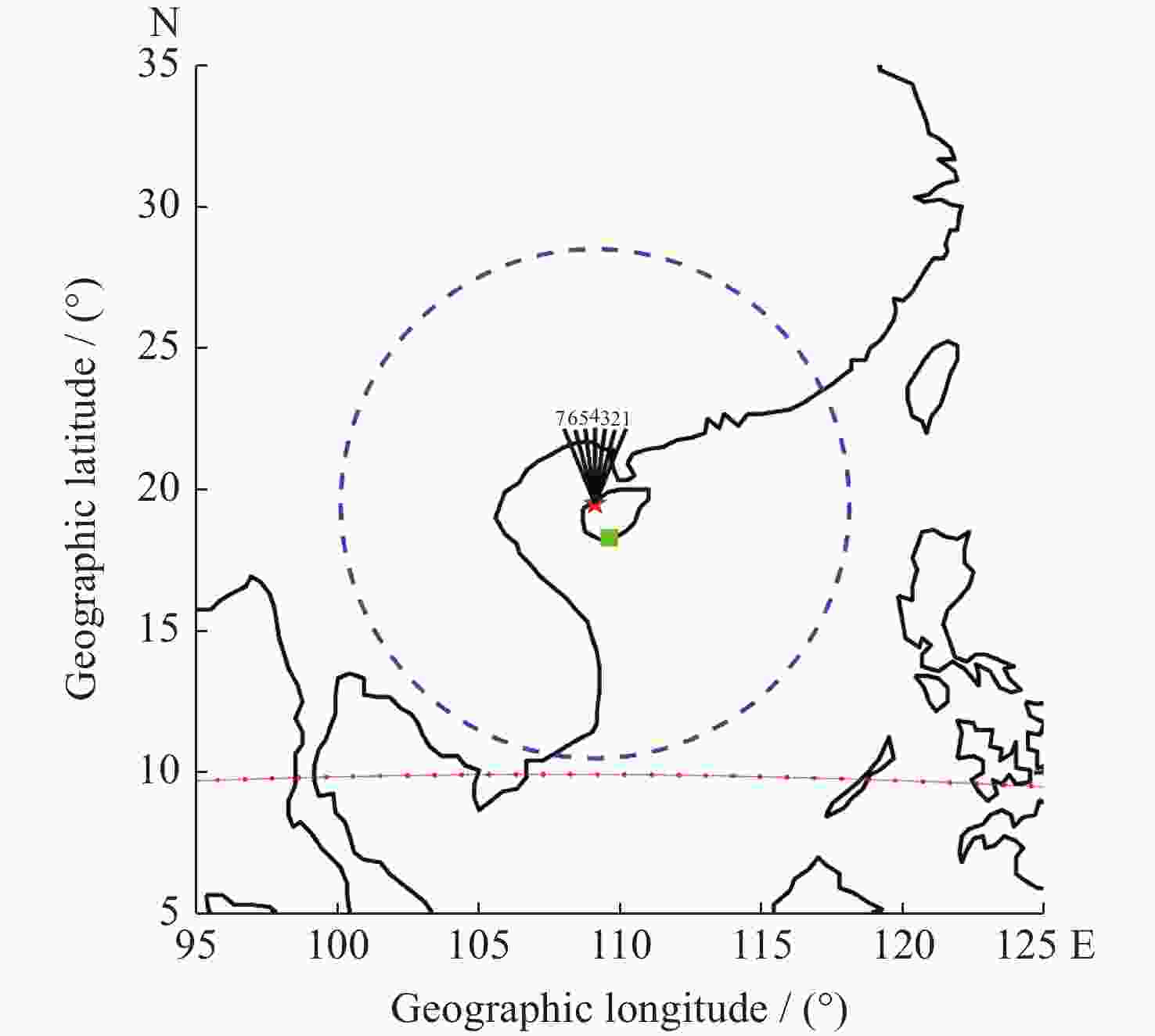
 下载:
下载:
